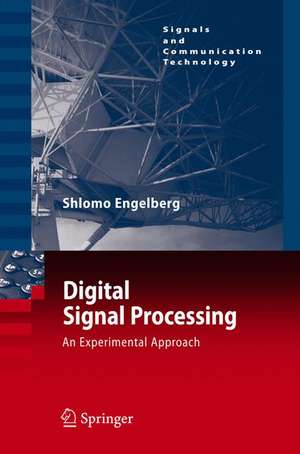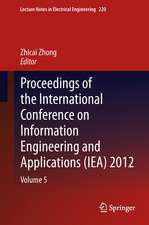Digital Signal Processing: An Experimental Approach: Signals and Communication Technology
Autor Shlomo Engelbergen Limba Engleză Hardback – 4 ian 2008
MATLAB® is employed to visualise the mathematics underlying this discipline, making clear its engineering relevance. The practical microprocessor-oriented parts of the book are introduced with special reference to the ADuC841, an lab manual for which is available. These labs can be transposed for other microprocessors. Problems are provided at the end of each chapter and an electronic solutions manual is available for tutors.
| Toate formatele și edițiile | Preț | Express |
|---|---|---|
| Paperback (1) | 384.48 lei 6-8 săpt. | |
| SPRINGER LONDON – 22 oct 2010 | 384.48 lei 6-8 săpt. | |
| Hardback (1) | 390.08 lei 6-8 săpt. | |
| SPRINGER LONDON – 4 ian 2008 | 390.08 lei 6-8 săpt. |
Din seria Signals and Communication Technology
- 20%
 Preț: 338.91 lei
Preț: 338.91 lei - 18%
 Preț: 1559.80 lei
Preț: 1559.80 lei - 15%
 Preț: 585.90 lei
Preț: 585.90 lei - 15%
 Preț: 585.26 lei
Preț: 585.26 lei - 18%
 Preț: 847.11 lei
Preț: 847.11 lei - 17%
 Preț: 361.80 lei
Preț: 361.80 lei -
 Preț: 393.35 lei
Preț: 393.35 lei - 20%
 Preț: 1002.72 lei
Preț: 1002.72 lei - 15%
 Preț: 641.71 lei
Preț: 641.71 lei - 18%
 Preț: 952.89 lei
Preț: 952.89 lei - 18%
 Preț: 1579.66 lei
Preț: 1579.66 lei - 18%
 Preț: 811.61 lei
Preț: 811.61 lei - 18%
 Preț: 727.97 lei
Preț: 727.97 lei - 18%
 Preț: 896.08 lei
Preț: 896.08 lei - 18%
 Preț: 905.54 lei
Preț: 905.54 lei - 15%
 Preț: 646.43 lei
Preț: 646.43 lei - 20%
 Preț: 662.48 lei
Preț: 662.48 lei - 15%
 Preț: 641.20 lei
Preț: 641.20 lei - 18%
 Preț: 1847.84 lei
Preț: 1847.84 lei - 18%
 Preț: 946.24 lei
Preț: 946.24 lei - 18%
 Preț: 1241.10 lei
Preț: 1241.10 lei - 20%
 Preț: 649.43 lei
Preț: 649.43 lei - 20%
 Preț: 993.28 lei
Preț: 993.28 lei - 18%
 Preț: 940.57 lei
Preț: 940.57 lei - 18%
 Preț: 945.62 lei
Preț: 945.62 lei - 18%
 Preț: 1389.30 lei
Preț: 1389.30 lei - 20%
 Preț: 1003.50 lei
Preț: 1003.50 lei - 18%
 Preț: 953.52 lei
Preț: 953.52 lei - 20%
 Preț: 1001.16 lei
Preț: 1001.16 lei - 18%
 Preț: 1415.36 lei
Preț: 1415.36 lei - 15%
 Preț: 653.33 lei
Preț: 653.33 lei - 15%
 Preț: 645.60 lei
Preț: 645.60 lei - 15%
 Preț: 637.28 lei
Preț: 637.28 lei - 18%
 Preț: 948.79 lei
Preț: 948.79 lei - 18%
 Preț: 836.36 lei
Preț: 836.36 lei - 18%
 Preț: 1230.84 lei
Preț: 1230.84 lei - 15%
 Preț: 635.01 lei
Preț: 635.01 lei - 15%
 Preț: 639.25 lei
Preț: 639.25 lei - 15%
 Preț: 646.30 lei
Preț: 646.30 lei - 15%
 Preț: 639.25 lei
Preț: 639.25 lei - 15%
 Preț: 712.36 lei
Preț: 712.36 lei - 20%
 Preț: 1006.12 lei
Preț: 1006.12 lei - 18%
 Preț: 970.56 lei
Preț: 970.56 lei - 15%
 Preț: 701.59 lei
Preț: 701.59 lei
Preț: 390.08 lei
Nou
Puncte Express: 585
Preț estimativ în valută:
74.65€ • 78.03$ • 63.08£
74.65€ • 78.03$ • 63.08£
Carte tipărită la comandă
Livrare economică 06-20 martie
Preluare comenzi: 021 569.72.76
Specificații
ISBN-13: 9781848001183
ISBN-10: 1848001185
Pagini: 232
Ilustrații: XVI, 212 p. With online files/update.
Dimensiuni: 155 x 235 x 18 mm
Greutate: 0.46 kg
Ediția:2008
Editura: SPRINGER LONDON
Colecția Springer
Seria Signals and Communication Technology
Locul publicării:London, United Kingdom
ISBN-10: 1848001185
Pagini: 232
Ilustrații: XVI, 212 p. With online files/update.
Dimensiuni: 155 x 235 x 18 mm
Greutate: 0.46 kg
Ediția:2008
Editura: SPRINGER LONDON
Colecția Springer
Seria Signals and Communication Technology
Locul publicării:London, United Kingdom
Public țintă
ResearchCuprins
The Analysis of Discrete-time Signals.- Understanding Sampling.- Signal Reconstruction.- Time-limited Functions Are Not Band-limited.- Fourier Analysis and the Discrete Fourier Transform.- Windowing.- Signal Generation with the Help of MATLAB.- The Spectral Analysis of Random Signals.- Analog to Digital and Digital to Analog Converters.- The General Structure of Sampled-data Systems.- The Operational Amplifier: An Overview.- A Simple Digital to Analog Converter.- The Binary Weighted DAC.- The R-2R Ladder DAC.- The Successive Approximation Analog to Digital Converter.- The Single- and Dual-slope Analog to Digital Converters.- The Pipelined A/D.- Resistor-chain Converters.- Sigma-Delta Converters.- Digital Filters.- Discrete-time Systems and the Z-transform.- Filter Types.- When to Use C (Rather than Assembly Language).- Two Simple FIR Filters.- Very-narrow-band Filters.- Design of IIR Digital Filters: The Old-fashioned Way.- New Filters from Old.- Implementing an IIR Digital Filter.- IIR Filter Design Using MATLAB.- Group Delay and Phase Delay in Filters.- Design of FIR Filters.- Implementing a Hilbert Filter.- The Goertzel Algorithm.
Recenzii
From the reviews:
"The novelty of this book lies in providing the student the subsequent transforms in DSP in a concise manner, in an experimental way by a large use of MATLAB and SIMULINK. … The book is accessible to students familiar with the main facts from a Signals-and-Systems course." (Dumitru Stanomir, Zentralblatt MATH, Vol. 1141, 2008)
"The novelty of this book lies in providing the student the subsequent transforms in DSP in a concise manner, in an experimental way by a large use of MATLAB and SIMULINK. … The book is accessible to students familiar with the main facts from a Signals-and-Systems course." (Dumitru Stanomir, Zentralblatt MATH, Vol. 1141, 2008)
Textul de pe ultima copertă
Digital Signal Processing is a mathematically rigorous but accessible treatment of digital signal processing that intertwines basic theoretical techniques with hands-on laboratory instruction. Divided into three parts, the book covers various aspects of the digital signal processing (DSP) "problem". It begins with the analysis of discrete-time signals and explains sampling and the use of the discrete and fast Fourier transforms. The second part of the book—covering digital to analog and analog to digital conversion—provides a practical interlude in the mathematical content before Part III lays out a careful development of the Z-transform and the design and analysis of digital filters.
MATLAB® and Simulink® are employed extensively to allow the reader to experience the beautiful mathematics underlying this important discipline, and to demonstrate the subject’s engineering relevance. The practical microprocessor-oriented parts of Digital Signal Processing are introduced with special reference to the ADuC841, a lab manual for which can be downloaded from www.springer.com/978-1-84800-118-3. These labs can be easily transposed for other microprocessors. Problems are provided at the end of each chapter and an electronic solutions manual is available for tutors.
Academic tutors of courses in DSP will find this book to be an invaluable aid in explaining the fundamental mathematics of digital signal processing and drawing out its significance for engineers. Electrical and computer engineers working in signals- and communications-related fields can use the book as a reference or for self-tuition and for deepening their understanding of the techniques they use. Graduate applied mathematics, electrical, electronic and computer engineering students interested in DSP will learn the underlying mathematics of a vital engineering discipline and how to apply it in practical laboratory situations.
MATLAB® and Simulink® are employed extensively to allow the reader to experience the beautiful mathematics underlying this important discipline, and to demonstrate the subject’s engineering relevance. The practical microprocessor-oriented parts of Digital Signal Processing are introduced with special reference to the ADuC841, a lab manual for which can be downloaded from www.springer.com/978-1-84800-118-3. These labs can be easily transposed for other microprocessors. Problems are provided at the end of each chapter and an electronic solutions manual is available for tutors.
Academic tutors of courses in DSP will find this book to be an invaluable aid in explaining the fundamental mathematics of digital signal processing and drawing out its significance for engineers. Electrical and computer engineers working in signals- and communications-related fields can use the book as a reference or for self-tuition and for deepening their understanding of the techniques they use. Graduate applied mathematics, electrical, electronic and computer engineering students interested in DSP will learn the underlying mathematics of a vital engineering discipline and how to apply it in practical laboratory situations.
Caracteristici
Gives the reader an understanding of the mathematical principles and theories that underlie digital signal processing Enables the reader to cover the essentials without requiring 700+ pages Guides the reader through experiments that can be simulated using MATLAB® or performed using a microprocessor Includes supplementary material: sn.pub/extras Request lecturer material: sn.pub/lecturer-material















